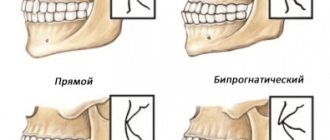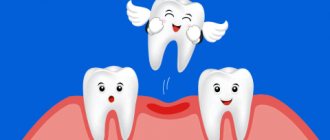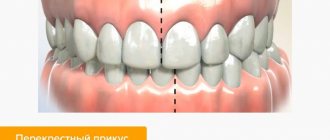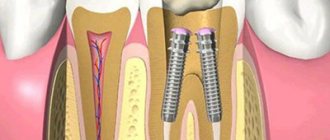The formation of a primary occlusion is a multi-stage process, which is characterized by a number of features that can largely affect the further development of a person’s dentition. It is during this period that the fundamental basis of the dentofacial apparatus is formed.
Primary occlusion is characterized by gradual teething, and it is sequential in nature - teeth erupt one after another. The characteristics of primary teeth differ from those of permanent teeth.
There are two stages of primary occlusion:
- emerging: the period from the appearance of the first tooth, usually between the ages of 6 months and 3 children. Characterized by active eruption and growth of baby teeth. It is at this stage that it is recommended to make the first visit to the dentist and orthodontist - at the age of 2-3 years;
- formed: characterized by the presence of all teeth and active growth of the jaws.
Development of primary occlusion
The primary occlusion is one of the most important periods in the formation of the dentofacial system. The fact is that even the slightest deviation that occurs at this time can lead to the development of serious violations in the future.
To assess the correct development of the primary occlusion, the following characteristics are used:
- timing of eruption: normally, the first milk tooth erupts at 6 months, and the last at 30 months. The norm is also a deviation of 3-5 months. Violation of eruption juices is the main sign of the presence of anomalies in the development of the dentofacial apparatus;
- pairing: during the period of primary occlusion, simultaneous eruption of antagonist teeth occurs on both sides of the jaw. Growth retardation of one of them for a period of no more than 1 month is the norm. A more significant violation of pairing may signal disturbances in the development of the jaw, for example, slow growth of bone tissue.
Change of primary occlusion in children: what parents need to know
A formed primary bite consists of 20 primary teeth, which is exactly the number observed in healthy three-year-old children. By the age of 14, natural replacement of baby teeth with permanent ones occurs. During the period when a change is about to occur, the roots of temporary teeth begin to collapse and dissolve, giving way to the developing rudiments of permanent teeth.
The replacement of baby teeth begins by the age of 6 years. According to medical indicators, the change of baby teeth should occur over approximately 8 years - from 6 to 14. Because no two organisms are the same, the timing and periods of shifts are individual for each child. But the sequence in which this process occurs is always the same. Your baby's front baby teeth will, of course, be the first to be updated.
By the age of 5-6 years, during the period of active growth of the child, the size of the jaw also increases. The spaces between baby teeth increase. This is explained by the fact that the permanent ones will be larger and they need more space for full growth. If the distance remains the same, the teeth will come out crookedly, in the place where there is more space.
A common misconception is that as soon as the first teeth are renewed, it is necessary to urgently visit the dentist to adjust their correction with a braces system. There is no need, even if the teeth grow at different angles and at large intervals. The period from 6 to 7 years provides for this type of development; this process is subject to self-regulation, and ultimately the teeth will “fall into place” on their own.
The first molars will appear behind them - these are the sixth teeth from the middle of the jaw (the so-called six). A place for them will be formed only when the baby’s jaw gets stronger.
Next comes the resting stage. And only from 9 to 11 years of age the lateral teeth are replaced, the baby molars are replaced with premolars - a support zone is formed. And by the age of 13-14 years, a permanent bite is established.
Possible problems:
- Molars begin to grow before baby teeth fall out. Some babies develop two rows at the same time. However, doctors say that there is nothing wrong with this, and the milk will still fall out, and the root will take its place to the fullest extent. If a baby tooth does not fall out for three months or longer, then you should consult a doctor;
— Pain and discomfort often occur during teething, and sometimes the temperature rises. If the temperature lasts longer than three days, accompanied by vomiting and nausea, be sure to consult a dentist. To relieve inflammation and discomfort at home, you can use special gels for teething gums.
You can make an appointment with a pediatric dentist on our website. Children's dentists provide consultations at the branches of the ANO "Association "Dentistry": No. 4 (Gurzufskaya St., 16), No. 16 (Starykh Bolshevikov St., 27).
How is a milk bite different from a permanent bite?
Signs of a milk bite are:
- the length and radius of the upper tooth are usually greater than the same parameters for the lower tooth;
- the dentitions have a semicircular, symmetrical shape;
- the interdental space of the front teeth coincides on the upper and lower jaws;
- not all teeth of the same name touch each other;
- the enamel is intact and does not wear off;
- There is no overlap of the lower row of teeth with the upper ones.
As the dentofacial system develops, these signs become less pronounced and completely disappear by the period of permanent dentition.
The main difference between a temporary bite and a permanent one is the number of teeth. With a permanent bite, there are normally 32 of them, and with a milk bite there are only 20. The shape of the teeth also differs: temporary teeth have a more convex shape with a pronounced relief, while permanent teeth are smooth and flat.
Changeable bite
This stage begins at the age of five or six years. At this point, the oral cavity contains both milk and molars, and the former are just beginning to fall out.
The replacement bite consists of two stages:
- appearance of incisors and sixth teeth;
- eruption of lateral units.
Features of a replaceable bite:
- rapid jaw growth;
- dental mobility;
- resorption of the roots of baby teeth.
The help of a dentist during this period may be needed if the permanent tooth has erupted, but the milk tooth in its place has not yet fallen out.
When all the baby teeth have fallen out, the period of mixed dentition ends.
How to prevent the development of anomalies?
Some parents mistakenly believe that deviations in the development of the jaws at the stage of primary occlusion are only temporary and do not need to be treated. This is wrong.
To prevent possible serious consequences that arise already during permanent occlusion, parents need to visit the dentist in a timely manner - the first visit should take place at the age of 2-3 years, if indicated, it is necessary to undergo an examination by an orthodontist.
It is also necessary to prevent the development of harmful orthodontic habits in a child: prohibit gnawing and sucking objects, intentionally swallowing incorrectly, breathing through the mouth with normal nasal breathing.
Permanent bite
Stages of development:
- appearance of the last molars;
- the appearance of wisdom teeth and the development of jaw arches;
- The formation of the jaw bones ends (age about twenty-five years).
Anomalies of permanent occlusion can develop due to developmental failures at previous stages of formation.
How to prevent the development of pathologies:
- proper breastfeeding of the baby;
- prevention of rickets;
- weaning yourself from the habit of constantly sucking a pacifier;
- constant care of teeth and gums;
- properly selected hygiene products;
- timely change of toothbrush;
- timely introduction of solid foods into the diet.
Prevention will help reduce the risk of developing malocclusion. However, unfortunately, there are factors that are not related to oral care and timely prevention. Other causes of malocclusion include:
- genetic predisposition;
- underdeveloped jaw muscles;
- ENT diseases, due to which the child’s mouth is always open;
- jaw injury.
If symptoms of malocclusion are detected, parents should immediately consult a dentist, since the consequences of the anomaly can be serious:
- intestinal problems;
- breathing problems;
- incorrect pronunciation of sounds;
- diseases of the ENT organs;
- problems with teeth and gums.
III PERIOD - from 9 months to 3 years (formation of temporary bite)
Prevention of dental anomalies:
- massage of the alveolar processes of the jaws for difficult eruption of baby teeth
- monitoring the sequence of eruption of primary teeth and their establishment in the dentition
- the use of medicated nipples that apply pressure to an overdeveloped area of the jaw
- preventing the development of bad habits: thumb sucking, constant sucking on pacifiers, placing a fist under the cheek while sleeping, etc.
- identification of habitual incorrect posture (standing, sitting, lying), postural disorders and flat feet
- therapeutic exercises, massage, orthopedic consultation
- normalization of lip closure, nasal breathing, correct positioning of the lower jaw with the help of therapeutic exercises and vestibular plates
- detection of dental anomalies. Orthodontist consultation. Dispensary observation
How to suspect the development of a defect
How to identify malocclusion in a baby. Even a non-specialist can suspect the formation of this problem.
We list the most characteristic signs:
- uneven dental arches;
- crowding of teeth and their rotation around their axis;
- growth of units in the wrong place;
- gaps between teeth;
- presence of extra units;
- excessive overlap of the upper or lower jaw arches;
- no closure of incisors;
- facial asymmetry;
- moving one of the jaws forward;
- constantly open mouth;
- difficulty in nasal breathing;
- pathological abrasion of teeth;
- traces of injuries on the inner surface of the lips, tongue, cheeks;
- increased tone of facial muscles;
- difficulty chewing food;
- difficulty producing sounds.
Having discovered one or more of the listed signs in their baby, parents should take him to an orthodontist as soon as possible.
Stages of dental development from birth to 12-14 years
The formation of teeth in children occurs in several stages. By the age of 3, a properly developing baby should erupt in pairs of milk teeth - 10 each on the lower and upper jaw. Usually they are located quite close to each other and close together without forming “steps”. A slight overlap of the lower teeth by the upper ones is normal.
By the age of six, teeth begin to wear down and gaps appear between them. The stage of eruption of permanent teeth and the formation of a removable bite begins, which lasts until approximately 12-14 years. As statistics show, by this time, dentists have already observed defects in eight out of ten schoolchildren, and parents begin to wonder whether it is possible to get braces to correct the dentition.
PERIOD IX - from 21 to 40 years (active functions of the dental system)
Prevention and treatment of dental anomalies:
- regular sanitation of the oral cavity, compliance with hygiene rules using special-purpose products
- observation by a periodontist, treatment of periodontal diseases
- professional oral hygiene
- restoration of crowns of damaged teeth
- replacement of missing teeth using implantation and prosthetics
- removal of 3 molars
- selective grinding of teeth and elimination of traumatic occlusion
- achieving multiple contacts between teeth with various types of articulation and occlusion of the dentition
- prevention of diseases of the temporomandibular joints
- food hygiene
- elimination of calcium deficiency
- sports, fitness, swimming
- identification and elimination of risk factors
- fighting bad habits
- prevention of secondary dentofacial deformations
no images were found
Causes of curvature
Why can the bite of baby teeth be incorrect? There are several reasons.
- The habit of putting everything in your mouth. Most children learn about the world by “tasting” it in the literal sense. The habit of chewing pacifiers, toys, pencils and other objects leads to divergence of the front teeth, and, accordingly, to malocclusion.
- Mouth breathing. An increase in the load on the jaw bones during breathing occurs with frequent colds, deviated nasal septum, inflammation of the adenoids and allergic asthma.
- Genetics. Children inherit a small jaw from one parent, and large teeth from the other, and vice versa. Violation of physiological proportions prevents the even position of the dentition in the oral cavity.
- Insufficient load on the jaw. The period of growth of baby teeth is the optimal time for switching from liquid cereals and purees to carrots, apples, cabbage and other foods that require chewing. If this load is not enough, partial atrophy occurs, which contributes to malocclusion.
- Early loss of baby teeth. By not turning to a specialist, you are dooming your child to rapid destruction and tilting of teeth in different directions.










